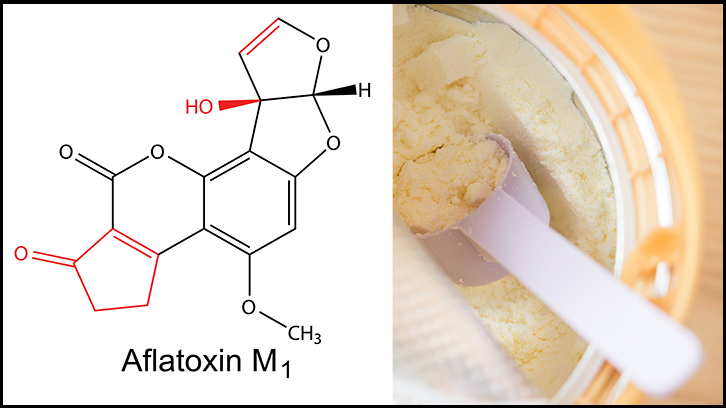Determination of aflatoxin M1 in infant formulas distributed in Monterrey, Mexico

The presence of Aflatoxin M1 (AFM1) in milk and other dairy products is a risk factor for the health of humans. This is particularly true in infants, a vulnerable group, since they are exposed to these toxins through baby formula. This article expands the literature on this problematic together with the efforts made by regulation agencies to control the amount of AFM1, given the difficulty to eliminate it during the production process of milk derivatives. The study shows the results obtained with baby formula sold in Mexico and the risk associated with consuming these products in infants two and under.
The presence of aflatoxins in food is a major health concern for regulatory agencies worldwide. These toxins include about 20 metabolites produced by molds such as Aspergillus flavus and A. parasiticus. From these, aflatoxin B1 (AFB1) is the most important and is normally found in foods, especially those that are high in carbohydrates and/or fats. Its occurrence has been reported in numerous foods and feeds, including cereals and cereal products.
Feeding cattle with AFB1-contaminated crops can lead to the formation of a metabolite called aflatoxin M1 (AFM1), which is excreted in the milk of lactating animals. The percentage of AFM1 excreted depends on several factors, including the concentration of AFB1 in the consumed crops, milk production, stage of lactation, and breed. The main problem with this aflatoxin ingests is that it has been demonstrated to be an important carcinogen.
Another important issue related to the presence of AFM1 in milk is the great variety of products made from it, such as liquid milk, yogurt, cheese, milk powder, ice cream, cream, among others, and the fact that this aflatoxin cannot be removed by regular heat treatments applied such as pasteurization or ultra-high temperature processing. One of the most important products made from milk is infant formulae, in which there is a significant risk of AFM1 poisoning because low concentrations of this toxin in the product can represent a significant risk for infants who consume them. Despite the danger associated with the presence of AFM1 in milk, few articles are published on the presence of this toxin in milk and dairy products in Mexico, and no studies have been published on its presence in dairy formulas in that country.
Researchers from the Center for Innovation, Research and Transfer in Food Technology (CIRTTA) of the Veterinary Faculty of the UAB and of the Faculty of Public Health and Nutrition of the Universidad Autónoma de Nuevo León (Mexico) have carried out a study whose objective has been to evaluate the presence of AFM1 in infant formulae distributed in Monterrey (Nuevo León, Mexico). To achieve this, 55 powdered infant formulas were examined, classified into two groups, starting formulae (0 to 12 months) and follow-on (1 to 2 years). The results showed that 11 of the 55 samples evaluated (20%) presented values above the limit established by the European Union for infant formulas (25 ng/L), in a very wide range (40 to 450 ng/L). These results show the need for an additional effort by regulatory agencies to reduce the presence of AFM1 in milk and thus in infant formulas that are consumed in this region of Mexico.
Genaro Amador Espejo1 and Antonio José Trujillo Mesa2
1 CONACYT–Research Center in Applied Biotechnology-IPN, Mexico.
2 Food Technology Area, Department of Animal and Food Science. Universitat Autònoma de Barcelona (UAB).
References
Patricia A. Quevedo-Garza, Genaro G. Amador-Espejo, Rogelio Salas-García, Esteban G. Ramos-Peña, Antonio-José Trujillo (2020). Aflatoxin M1 Determination in Infant Formulae Distributed in Monterrey, Mexico. Toxins, 12(2):100. doi: 10.3390/toxins12020100

